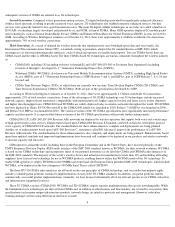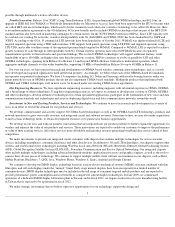Qualcomm 2011 Annual Report Download - page 19
Download and view the complete annual report
Please find page 19 of the 2011 Qualcomm annual report below. You can navigate through the pages in the report by either clicking on the pages listed below, or by using the keyword search tool below to find specific information within the annual report.
are delayed, our revenues could be negatively impacted, and our business could suffer.
Our licensing revenues can be impacted by the deployment of other technologies in place of technologies based on CDMA, OFDMA and
their derivatives or by the need to extend certain existing license agreements to cover additional later patents.
Although we own a very strong portfolio of issued and pending patents related to GSM, GPRS, EDGE, OFDM, OFDMA, WLAN and
Multiple Input, Multiple Output (MIMO) technologies, our patent portfolio licensing program in these areas is less established and might not be
as successful in generating licensing income as our CDMA licensing program. Many wireless operators are investigating or have selected LTE
(or to a lesser extent WiMAX) as next-generation technologies for deployment in existing or future spectrum bands as complementary to their
existing CDMA-based networks. Although we believe that our patented technology is essential and useful to implementation of the LTE and
WiMAX industry standards and have granted royalty-bearing licenses to 13 companies (including LG, Nokia and Samsung) to make and sell
products implementing those standards but not implementing 3G standards, the royalty rates for such products are generally lower than our
royalty rates for 3G products (whether or not such 3G products also incorporate a LTE or WiMAX mode of operation), and therefore, we might
not achieve the same licensing revenues on such LTE or WiMAX products as on CDMA-based or multimode CDMA/OFDMA-based products.
The licenses granted to and from us under a number of our license agreements include only patents that are either filed or issued prior to a
certain date and, in a small number of agreements, royalties are payable on those patents for a specified time period. As a result, there are
agreements with some licensees where later patents are not licensed by or to us under our license agreements. In order to license any such later
patents, we will need to extend or modify our license agreements or enter into new license agreements with such licensees. We might not be able
to modify such license agreements in the future to license any such later patents or extend such date(s) to incorporate later patents without
affecting the material terms and conditions of our license agreements with such licensees, and such modifications may impact our revenues.
Global economic conditions that impact the communications industry could negatively affect the demand for our products and our customers
’ products, which may negatively affect our revenues.
Continued volatility in capital markets or a future decline in global economic conditions, particularly in geographic regions with high
customer concentrations, could have adverse, wide-ranging effects on demand for our products and for the products of our customers,
particularly wireless communications equipment manufacturers or others in the wireless industry who buy their products, such as wireless
operators. Any prolonged financial or economic crisis may result in a downturn in demand for our products or technology; the insolvency of key
suppliers resulting in product delays; delays in reporting and/or payments from our licensees and/or customers; failures by counterparties; and
negative effects on wireless device inventories. In addition, our direct and indirect customers’ ability to purchase or pay for our products and
services, obtain financing and upgrade wireless networks could be adversely affected by economic conditions, leading to cancellation or delay of
orders for our products.
Our industry is subject to competition in an environment of rapid technological change that could result in decreased demand for our
products and the products of our customers and licensees, declining average selling prices for our licensees
’ products and our products
and/or new specifications or requirements placed upon our products, each of which could negatively affect our revenues and operating
results.
Our industry is subject to rapid technological change, and we must make substantial investments in new products, services and technologies
to compete successfully. Technological innovations generally require a substantial investment before they are commercially viable. We intend to
continue to make substantial investments in developing new products and technologies, and it is possible that our development efforts will not be
successful and that our new technologies will not result in meaningful revenues. Our products, services and technologies face significant
competition, and the revenues generated or the timing of their deployment, which may be dependent on the actions of others, may not meet our
expectations. Competition in the communications industry is affected by various factors that include, among others: evolving industry standards;
evolving methods of transmission for voice and data communications; networking; value-added features that drive replacement rates and selling
prices; turnkey, integrated product offerings that incorporate hardware, software, user interface and applications; scalability and the ability of the
system technology to meet customers’ immediate and future network requirements.
Our future success will depend on, among other factors, our ability to:
14
• increase demand for our integrated circuit products and drive their adoption across a broad spectrum of devices, such as smartphones
and tablets, and into new areas of wireless connectivity, including gaming, wireless charging and the connected home;
• strengthen our integrated circuit product roadmap for, and develop channel relationships in, emerging geographic regions requiring
turnkey product offerings for low-end smartphones;
• be a preferred partner for operating system platforms, such as Android and Windows Phone, and effectively
























